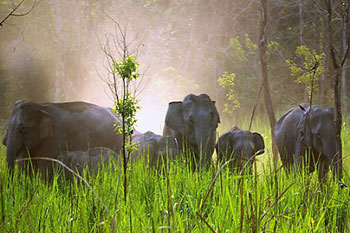JIGME DORJI NATIONAL PARK – The Joyful Discovery of Nature

The altitudes vary from about 1500 m in the south to over 6400m in the north and provide an expansive backdrop for different ecosystems. As obvious, the south regions host warm broad leaved forests and extend towards the permanent ice-fields and glaciers on the northwest Bhutan border. Another important highlight of this park is that three major Bhutanese rivers namely, Kulong Chhu, Khoma Chhu and Sheri Chhu originate from here. Renowned peaks such as Jomolhari, Tsherimgang and Jichu Drakey are prominent landmarks inside the protected areas.
In terms of flora and fauna, the park presents rich plant and animal diversity. Many flowers like Bhutan’s national flower – blue poppy, orchids, rhodendrons, edelweiss etc bloom here in season. Another outstanding feature of this location is that it is the only place in the world to serve as home for Royal Bengal Tiger and Snow Leopard. The coexistence of both the species again speaks volumes about the sheer diversity of landscapes and thriving zones here. Other important species that continue to flourish in the region are the Black Bear, Red Panda, Musk Deer and Blue Sheep.
The next important attraction of this varied ecosystem is the presence of different trekking routes. During a visit to Jigme Dorji National Park, tourists can have an enriched experience of trekking along with wildlife safari. The trekkers pass through paradisiacal alpine meadows and snow-capped mountains while enjoying the pristine setting of this wildlife park. Apart from this, the park also has numerous hot springs and medicinal baths that again attract a lot of visitors.
How to Reach Jigme Dorji National Park
Punakha is the closest destination to Jigme Dorji National Park. One needs to drive northwards to reach the largest national park of Bhutan.
Best Time to Visit Jigme Dorji National Park
March to October is the best time to visit the park and experience the natural beauty. September in particular is considered the ideal time to plan a wildlife tour here.
